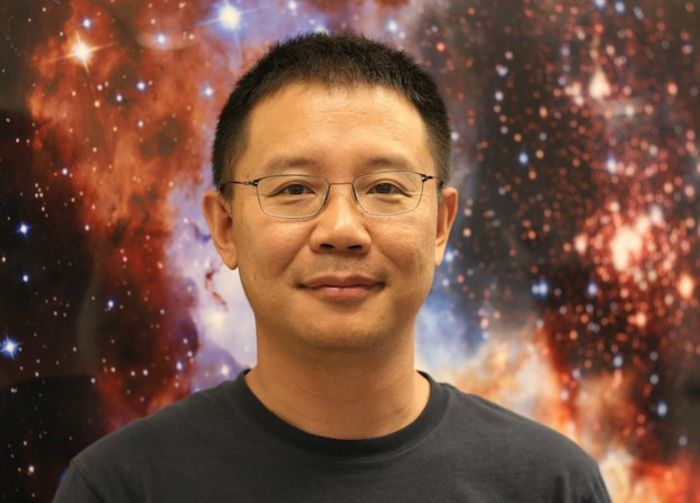RIVERSIDE, Calif. — A study co-led by physicists at UC Riverside and UC Irvine has found that dark matter halos of ultra-diffuse galaxies are very odd, raising questions about physicists’ understanding of galaxy formation and the structure of the universe.

Credit: Samantha Tieu.
RIVERSIDE, Calif. — A study co-led by physicists at UC Riverside and UC Irvine has found that dark matter halos of ultra-diffuse galaxies are very odd, raising questions about physicists’ understanding of galaxy formation and the structure of the universe.
Ultra-diffuse galaxies are so called because of their extremely low luminosity. The distribution of baryons — gas and stars — is much more spread out in ultra-diffuse galaxies compared to “normal” galaxies with similar masses.
In the following Q&A, Hai-Bo Yu, an associate professor of physics and astronomy at UCR, shares his thoughts on the findings he and UCI’s Manoj Kaplinghat, a long-term collaborator of Yu’s, have published in The Astrophysical Journal about newly discovered ultra-diffuse galaxies and their dark matter halos.
Yu and Kaplinghat were joined in the research by Demao Kong of Tufts University, and Filippo Fraternali and Pavel E. Mancera Piña of the University of Groningen in the Netherlands. First author Kong will join UCR this fall.
The research was supported by grants from the National Science Foundation, Department of Energy, John Templeton Foundation, National Aeronautics and Space Administration, Netherlands Research School for Astronomy, and ASTRON, the Netherlands Institute for Radio Astronomy.
Q. What is a dark matter halo?
A dark matter halo is the halo of invisible matter that permeates and surrounds a galaxy or a cluster of galaxies. Although dark matter has never been detected in laboratories, physicists are confident dark matter, which makes up 85% of the universe’s matter, exists.
Q. You’ve found dark matter halos of the ultra-diffuse galaxies are very odd. What is odd about them and what are you comparing them to?
The ultra-diffuse galaxies we studied are much less massive compared to, say, the Milky Way. They contain a lot of gas, however, and they have much higher gas mass than total stellar mass, which is opposite to what we see in the Milky Way. The ultra-diffuse galaxies also have large sizes.
The distribution of dark matter in these galaxies can be inferred from the motion of gas particles. What really surprises us is that the presence of baryonic matter itself, predominantly in the form of gas, is nearly sufficient to explain the measured velocity of gas particles and leaves little room for dark matter in the inner regions, where most of the stars and gas are located.
This is very surprising because in the case of normal galaxies, whose masses are similar to those of the ultra-diffuse galaxies, it’s the opposite: dark matter dominates over baryonic matter. To accommodate this result, we conclude that these dark matter halos must have much lower “concentrations.” That is, they contain much less mass in their inner regions, compared to those of normal galaxies. In this sense, dark matter halos of the ultra-diffuse galaxies are “odd.”
At first glance, one would expect that such low-concentration halos are so rare that the ultra-diffuse galaxies would not even exist. After looking into the data from state-of-the-art numerical simulations of cosmic structure formation, however, we found the population of low-concentration halos is higher than the expectation.
Q. What was involved in doing the study?
This is a collaborative work. Filippo Fraternali and his student Pavel E. Mancera Piña are experts on gas dynamics of galaxies. They discovered that the ultra-diffuse galaxies rotate more slowly than normal galaxies with similar masses. We worked together to interpret measurement data of the gas motion of these galaxies and infer their dark matter distribution. Furthermore, we analyzed data from simulations of cosmic structure formation and identified dark matter halos that have similar properties as those inferred from the ultra-diffuse galaxies.
Q. Your findings raise questions about our understanding of galaxy formation/structure formation of the universe. How?
We have many questions regarding the formation and evolution of these newly discovered galaxies. For example, the ultra-diffuse galaxies contain a lot of gas and we do not know how this gas is retained during galaxy formation. Further, our results indicate that these galaxies may be younger than normal galaxies. The formation of the ultra-diffuse galaxies is not well understood, and more work is needed.
Q. What makes ultra-diffuse galaxies so interesting?
These are amazing objects to study because of their surprising properties, as discussed in our work. The newly discovered ultra-diffuse galaxies provide a new window for further testing our understanding of galaxy formation, probably even the nature of dark matter.
The University of California, Riverside is a doctoral research university, a living laboratory for groundbreaking exploration of issues critical to Inland Southern California, the state and communities around the world. Reflecting California’s diverse culture, UCR’s enrollment is more than 26,000 students. The campus opened a medical school in 2013 and has reached the heart of the Coachella Valley by way of the UCR Palm Desert Center. The campus has an annual impact of more than $2.7 billion on the U.S. economy. To learn more, visit www.ucr.edu.
Journal
The Astrophysical Journal
DOI
10.3847/1538-4357/ac8875
Method of Research
Observational study
Subject of Research
Not applicable
Article Title
The Odd Dark Matter Halos of Isolated Gas-rich Ultradiffuse Galaxies
Article Publication Date
12-Sep-2022
COI Statement
No conflicting interests.




